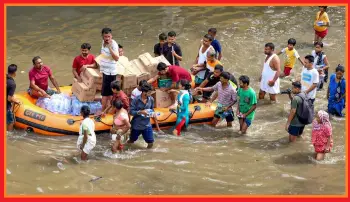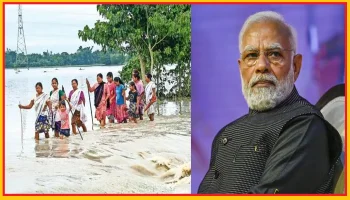PM Modi Reviews Assam Bihar Flood Situation, Orders Swift Relief Action
PM Modi reviews Assam Bihar flood situation and conducted a high-level meeting yesterday to asses the flood situation and analyze relief measures. The Prime Minister’s office confirmed that the review meeting was attended by senior officials from the National Disaster Response Force (NDRF), the Home Ministry, and both state governments. The main focus of PM Modi is expediting rescue operations, scaling up relief deployment, and ensuring funds and medical support reach the worst-hit regions without any delay.
PM Modi Reviews Assam Bihar Flood Situation in detail and emphasized a “zero-delay approach” to rescue efforts. He directed the NDRF to intensify field operations in flood-prone districts and deploy more battalions of NDRF wherever necessary.
Additionally, the Prime Minister approved the immediate release of central disaster relief funds to both states for providing temporary shelters, continuing food supplies, drinking water, and mobile medical units in the affected areas.
As per the sources, PM Modi told their officials that “The safety of every citizen is our top priority,”. “We must act quickly, work together, and ensure no one is left behind.”
Flood Situation:
Due to heavy monsoon rains major rivers crossed their danger level. Large parts of Assam and Bihar are severely affected due to widespread flooding. Resulting to widespread flood thousands of people have been displaced and their houses including infrastructures have been damaged across both states.
- Assam: Over 8 lakh people have been affected in 15 districts of Assam. Out of 15 affected districts, Darrang, Barpeta, and Dhubri are among the severely affected areas.
- Bihar: Several districts in north Bihar, including Katihar and Kishanganj, are severely affected. Rail connectivity and agriculture have been interrupted.
The Assam and Bihar flood situation has also prompted state authorities to close schools in affected regions and issue red alerts for continued heavy rainfall.
Relief Operations in affected areas
In both states, Indian Air Force helicopters are being used to air-drop relief materials. Boats and emergency teams are working round the clock to evacuate families. Medical camps have been set up to handle flood-related illnesses and injuries.
Local authorities are also leveraging technology—using drones and satellite images—to monitor water levels and direct resources to the most affected zones.
Central-State Coordination
In a strong display of cooperative federalism, PM Modi assured and extended full support from the Centre to both Chief Ministers. A joint task force has been established to continuously monitor and confirm real-time updates to PM Modi. PM Modi reviews Assam Bihar flood situation for quick decision-making.
Public Appeals and Advisories
Citizens in flood-hit areas are being urged to avoid unnecessary travel and follow official advisories. Relief helplines have been set up, and the government is appealing to NGOs and volunteers for coordinated aid efforts.

Conclusion
With the monsoon season far from over, the PM Modi review of the Assam Bihar flood situation comes at a critical juncture. The Centre’s proactive response, increased NDRF presence, and fund allocations offer hope and reassurance to the affected by this natural disaster.
As the nation watches closely, all eyes are now on how swiftly these measures can translate into real relief on the ground.
📌 FAQs: PM Modi Reviews Assam Bihar Flood Situation
Why did PM Modi hold a review meeting on the Assam and Bihar floods?
PM Modi held the review to assess the severity of the floods in both states, ensure rapid deployment of relief, and coordinate a timely response between central agencies and state governments.
Which areas are most affected by the floods?
In Assam, districts like Barpeta, Darrang, and Dhubri have been hit hard. In Bihar, Araria, Katihar, and Kishanganj are among the worst affected due to rising water levels in rivers and heavy rainfall.
What relief measures has the central government taken so far?
The Prime Minister approved additional deployments of the NDRF, immediate release of disaster relief funds, aerial surveys, and fast-tracked supply of food, water, and medical aid to flood-hit areas.
How many people have been affected in Assam and Bihar?
As of the latest reports, over 8 lakh people in Assam and lakhs more in Bihar have been impacted, with many displaced from their homes or taking shelter in relief camps.
What is the role of the NDRF in the flood response?
The National Disaster Response Force (NDRF) is conducting rescue operations, evacuating families, delivering essential supplies, and helping local administrations manage relief camps.
Is this year’s flooding worse than previous years?
Yes, both the intensity and impact of this year’s floods are more severe due to heavy monsoon rains, overflowing rivers, and weakened embankments. Climate change and poor infrastructure planning have made the situation worse.
Are helicopters and drones being used in the relief efforts?
Yes, the Indian Air Force is using helicopters for air-dropping relief materials, and drones are being deployed to monitor flood-affected regions and locate stranded communities.
What challenges are locals facing on the ground?
People are dealing with submerged homes, food and water shortages, damaged infrastructure, disrupted schools, and lack of medical assistance in remote areas.
How can citizens help during this flood crisis?
Citizens can donate to trusted NGOs and government-backed relief funds, volunteer with local rescue teams, or support awareness and resource-sharing efforts online.
Will this disaster lead to any long-term flood prevention plans?
Experts and environmentalists hope so. PM Modi’s intervention brings national attention, and there’s growing pressure for sustainable flood management, including early warning systems, better drainage, and stronger embankments.




